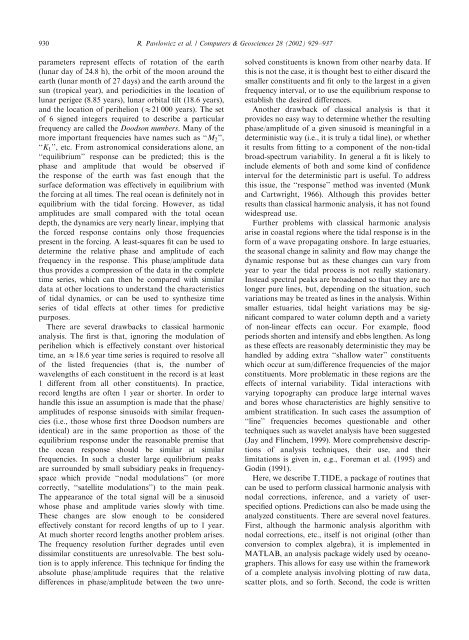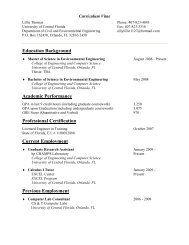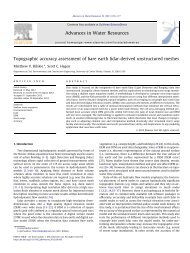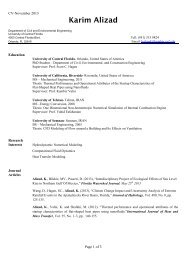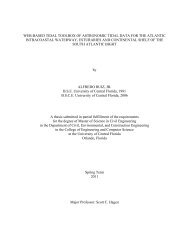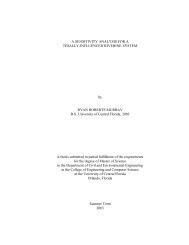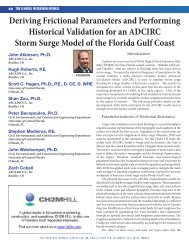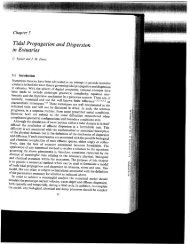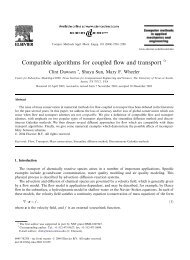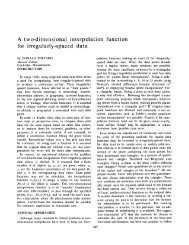Classical tidal harmonic analysis including error estimates in ...
Classical tidal harmonic analysis including error estimates in ...
Classical tidal harmonic analysis including error estimates in ...
Create successful ePaper yourself
Turn your PDF publications into a flip-book with our unique Google optimized e-Paper software.
930<br />
parameters represent effects of rotation of the earth<br />
(lunar day of 24:8 h), the orbit of the moon around the<br />
earth (lunar month of 27 days) and the earth around the<br />
sun (tropical year), and periodicities <strong>in</strong> the location of<br />
lunar perigee (8.85 years), lunar orbital tilt (18.6 years),<br />
and the location of perihelion (E21 000 years). The set<br />
of 6 signed <strong>in</strong>tegers required to describe a particular<br />
frequency are called the Doodson numbers. Many of the<br />
more important frequencies have names such as ‘‘M2’’,<br />
‘‘K1’’, etc. From astronomical considerations alone, an<br />
‘‘equilibrium’’ response can be predicted; this is the<br />
phase and amplitude that would be observed if<br />
the response of the earth was fast enough that the<br />
surface deformation was effectively <strong>in</strong> equilibrium with<br />
the forc<strong>in</strong>g at all times. The real ocean is def<strong>in</strong>itely not <strong>in</strong><br />
equilibrium with the <strong>tidal</strong> forc<strong>in</strong>g. However, as <strong>tidal</strong><br />
amplitudes are small compared with the total ocean<br />
depth, the dynamics are very nearly l<strong>in</strong>ear, imply<strong>in</strong>g that<br />
the forced response conta<strong>in</strong>s only those frequencies<br />
present <strong>in</strong> the forc<strong>in</strong>g. A least-squares fit can be used to<br />
determ<strong>in</strong>e the relative phase and amplitude of each<br />
frequency <strong>in</strong> the response. This phase/amplitude data<br />
thus provides a compression of the data <strong>in</strong> the complete<br />
time series, which can then be compared with similar<br />
data at other locations to understand the characteristics<br />
of <strong>tidal</strong> dynamics, or can be used to synthesize time<br />
series of <strong>tidal</strong> effects at other times for predictive<br />
purposes.<br />
There are several drawbacks to classical <strong>harmonic</strong><br />
<strong>analysis</strong>. The first is that, ignor<strong>in</strong>g the modulation of<br />
perihelion which is effectively constant over historical<br />
time, an E18:6 year time series is required to resolve all<br />
of the listed frequencies (that is, the number of<br />
wavelengths of each constituent <strong>in</strong> the record is at least<br />
1 different from all other constituents). In practice,<br />
record lengths are often 1 year or shorter. In order to<br />
handle this issue an assumption is made that the phase/<br />
amplitudes of response s<strong>in</strong>usoids with similar frequencies<br />
(i.e., those whose first three Doodson numbers are<br />
identical) are <strong>in</strong> the same proportion as those of the<br />
equilibrium response under the reasonable premise that<br />
the ocean response should be similar at similar<br />
frequencies. In such a cluster large equilibrium peaks<br />
are surrounded by small subsidiary peaks <strong>in</strong> frequencyspace<br />
which provide ‘‘nodal modulations’’ (or more<br />
correctly, ‘‘satellite modulations’’) to the ma<strong>in</strong> peak.<br />
The appearance of the total signal will be a s<strong>in</strong>usoid<br />
whose phase and amplitude varies slowly with time.<br />
These changes are slow enough to be considered<br />
effectively constant for record lengths of up to 1 year.<br />
At much shorter record lengths another problem arises.<br />
The frequency resolution further degrades until even<br />
dissimilar constituents are unresolvable. The best solution<br />
is to apply <strong>in</strong>ference. This technique for f<strong>in</strong>d<strong>in</strong>g the<br />
absolute phase/amplitude requires that the relative<br />
differences <strong>in</strong> phase/amplitude between the two unre-<br />
R. Pawlowicz et al. / Computers & Geosciences 28 (2002) 929–937<br />
solved constituents is known from other nearby data. If<br />
this is not the case, it is thought best to either discard the<br />
smaller constituents and fit only to the largest <strong>in</strong> a given<br />
frequency <strong>in</strong>terval, or to use the equilibrium response to<br />
establish the desired differences.<br />
Another drawback of classical <strong>analysis</strong> is that it<br />
provides no easy way to determ<strong>in</strong>e whether the result<strong>in</strong>g<br />
phase/amplitude of a given s<strong>in</strong>usoid is mean<strong>in</strong>gful <strong>in</strong> a<br />
determ<strong>in</strong>istic way (i.e., it is truly a <strong>tidal</strong> l<strong>in</strong>e), or whether<br />
it results from fitt<strong>in</strong>g to a component of the non-<strong>tidal</strong><br />
broad-spectrum variability. In general a fit is likely to<br />
<strong>in</strong>clude elements of both and some k<strong>in</strong>d of confidence<br />
<strong>in</strong>terval for the determ<strong>in</strong>istic part is useful. To address<br />
this issue, the ‘‘response’’ method was <strong>in</strong>vented (Munk<br />
and Cartwright, 1966). Although this provides better<br />
results than classical <strong>harmonic</strong> <strong>analysis</strong>, it has not found<br />
widespread use.<br />
Further problems with classical <strong>harmonic</strong> <strong>analysis</strong><br />
arise <strong>in</strong> coastal regions where the <strong>tidal</strong> response is <strong>in</strong> the<br />
form of a wave propagat<strong>in</strong>g onshore. In large estuaries,<br />
the seasonal change <strong>in</strong> sal<strong>in</strong>ity and flow may change the<br />
dynamic response but as these changes can vary from<br />
year to year the <strong>tidal</strong> process is not really stationary.<br />
Instead spectral peaks are broadened so that they are no<br />
longer pure l<strong>in</strong>es, but, depend<strong>in</strong>g on the situation, such<br />
variations may be treated as l<strong>in</strong>es <strong>in</strong> the <strong>analysis</strong>. With<strong>in</strong><br />
smaller estuaries, <strong>tidal</strong> height variations may be significant<br />
compared to water column depth and a variety<br />
of non-l<strong>in</strong>ear effects can occur. For example, flood<br />
periods shorten and <strong>in</strong>tensify and ebbs lengthen. As long<br />
as these effects are reasonably determ<strong>in</strong>istic they may be<br />
handled by add<strong>in</strong>g extra ‘‘shallow water’’ constituents<br />
which occur at sum/difference frequencies of the major<br />
constituents. More problematic <strong>in</strong> these regions are the<br />
effects of <strong>in</strong>ternal variability. Tidal <strong>in</strong>teractions with<br />
vary<strong>in</strong>g topography can produce large <strong>in</strong>ternal waves<br />
and bores whose characteristics are highly sensitive to<br />
ambient stratification. In such cases the assumption of<br />
‘‘l<strong>in</strong>e’’ frequencies becomes questionable and other<br />
techniques such as wavelet <strong>analysis</strong> have been suggested<br />
(Jay and Fl<strong>in</strong>chem, 1999). More comprehensive descriptions<br />
of <strong>analysis</strong> techniques, their use, and their<br />
limitations is given <strong>in</strong>, e.g., Foreman et al. (1995) and<br />
God<strong>in</strong> (1991).<br />
Here, we describe T TIDE, a package of rout<strong>in</strong>es that<br />
can be used to perform classical <strong>harmonic</strong> <strong>analysis</strong> with<br />
nodal corrections, <strong>in</strong>ference, and a variety of userspecified<br />
options. Predictions can also be made us<strong>in</strong>g the<br />
analyzed constituents. There are several novel features.<br />
First, although the <strong>harmonic</strong> <strong>analysis</strong> algorithm with<br />
nodal corrections, etc., itself is not orig<strong>in</strong>al (other than<br />
conversion to complex algebra), it is implemented <strong>in</strong><br />
MATLAB, an <strong>analysis</strong> package widely used by oceanographers.<br />
This allows for easy use with<strong>in</strong> the framework<br />
of a complete <strong>analysis</strong> <strong>in</strong>volv<strong>in</strong>g plott<strong>in</strong>g of raw data,<br />
scatter plots, and so forth. Second, the code is written


